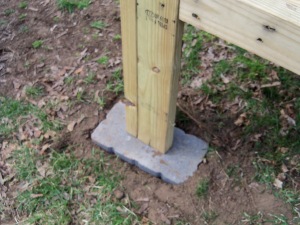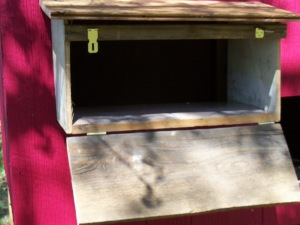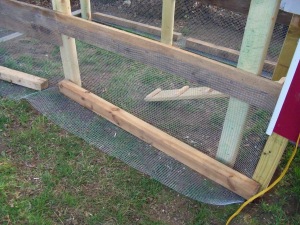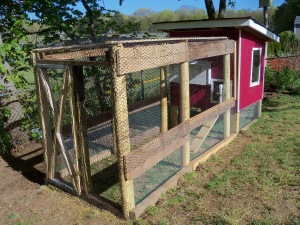My new family additions are hitting that awkward “teenage” stage….their feathers are coming in, they argue with each other more often, and they make a huge mess. I was told as they grow their feathers there would be dust everywhere. I didn’t think much of it…until now! I guess I just needed to see it to believe. So the girls were moved from the living room to their temporary home in the basement until their coop is ready.
Once moved, I tackled the spring cleaning of the upstairs. I decided to stick to natural cleaners and started off with lemon oil to clean off the dust and give the room a nice shine. With its main ingredient being mineral oil, I didn’t feel so bad using it. Searching through my cabinets to continue my cleaning, what I found was not exactly on my green list.

After several Google searches for recipes to try out, I’ve come up with a few that are worth repeating.
Laundry
My first homemade concoction to try out was fabric softener. I started letting my clothes dry on lines/racks in my basement to save on electricity. I noticed quickly that I didn’t like the “crunchy” feel of my clothes, especially my towels. Even letting them hang until almost dry and throwing them into the dryer for 10 minutes still didn’t soften them as I hoped. Browsing the internet, I came across this wonderful site full of recipes to try.
Her fabric softener is just the basics:
3 cups distilled white vinegar
1/4 cup of rubbing alcohol
15 drops of essential oil
Essential oil was something I’ve never tried, but easy enough to find. Amazon has a variety of scents to choose from. I purchased lavender oil for about $5 and plan on trying out other scents (peppermint….lemon….). After mixing them together, I store them in a labeled mason jar. Since using, my clothes have felt definitely softer with a nice fresh scent. And the price is cheaper than store bought. I can make a batch for under $3, compared to Walmart’s price on Downy Fabric softener of almost $4.
Next up was laundry detergent and who more willing (??) to be my guinea pig than my son (okay…maybe not so willing, but he did need his clothes washed). There were quite a few sites with homemade recipes, most with similar ingredients so I settled on this recipe with a slight modification.
Laundry detergent
1 cup washing soda
1 cup borax
1 bar castile soap, finely grated
3-5 drops essential oil (I used Dr. Bronner’s Lavender castile soap so I omitted the essential oil)

The grating of the soap took a while, but other than that it was easy to mix the ingredients which I stored in a recycled Chinese food container.

Two tablespoon fulls into the wash and we’re good to go. No soap residue, seemingly clean, with a slight lavender scent.
The soap itself was a bit pricey ($5.49 at Big Y) but the other ingredients were under $1 for the amounts I needed. If I made enough to match Gain 150 loads (Walmart price under $20) I found that my laundry detergent is quite expensive! I would be spending almost $40 for the same number of loads. Amazon also carries Castile soap for a lot cheaper ($2.30 for Kirk’s) bringing my homemade detergent to a comparable price of just under $20. An additional substitute of Ivory soap for Castile soap brings this recipe down to under $10! Next time, we try Ivory…wonder if I can get my son to test run it again….
In the Kitchen and Bath
Next up was the kitchen where I needed an all purpose cleaner. In the past I tried the diluted vinegar mixture (1/2 vinegar, 1/2 water) but the smell of vinegar made me feel like I was in a salad bowl. The essential oil “junky” that I’ve become, adding 10-12 drops into the mixture made a world of difference. Also stored in a mason jar under the kitchen sink, this extremely inexpensive (25 cents!) cleaner will be used frequently.
I have linoleum on my floors and wanted something to clean well and dry quick. I went back to naturesnurtureblog.com for this floor cleaner recipe:
1 cup water
1 cup vinegar
1 cup alcohol
2-3 drops dish soap
10-15 drops assorted essential oils (I only had lavendar so I went with it)
I mixed this recipe in (yet another!) recycled Chinese food container, dipped an old wash cloth in, wrung it out and secured it to a Swiffer mop.


Only issue I have was the essential oils. I only used lavender since it was all I had and I didn’t smell it as much as I thought. The original recipe called for lavender, orange, and peppermint…worth trying with these for a second time. Overall, a nice clean and the alcohol evaporates quickly making the floor dry in no time. For under $3 (that’s doubling the recipe) it is less expensive than the Swiffer 12 pack of wet wipes ($4.50) in the basement.
Having enough of the floor cleaner and all purpose cleaner for the bathroom, I just needed to whip up something for the toilet bowl. A 1/2 cup of baking soda, a couple drops of lavender oil, followed by a cup of vinegar cleaned it well. For under a quarter, I’ve got a clean bowl and I’m not dumping chemicals down the drain.
It’s good to know there are so many resource out there to experiment with when it comes to greener cleaning products. Not only am I sparing my family from the toxic chemicals in our past cleaners, I am also helping to preserve the environment. Safer, greener, and saving money too!


























































